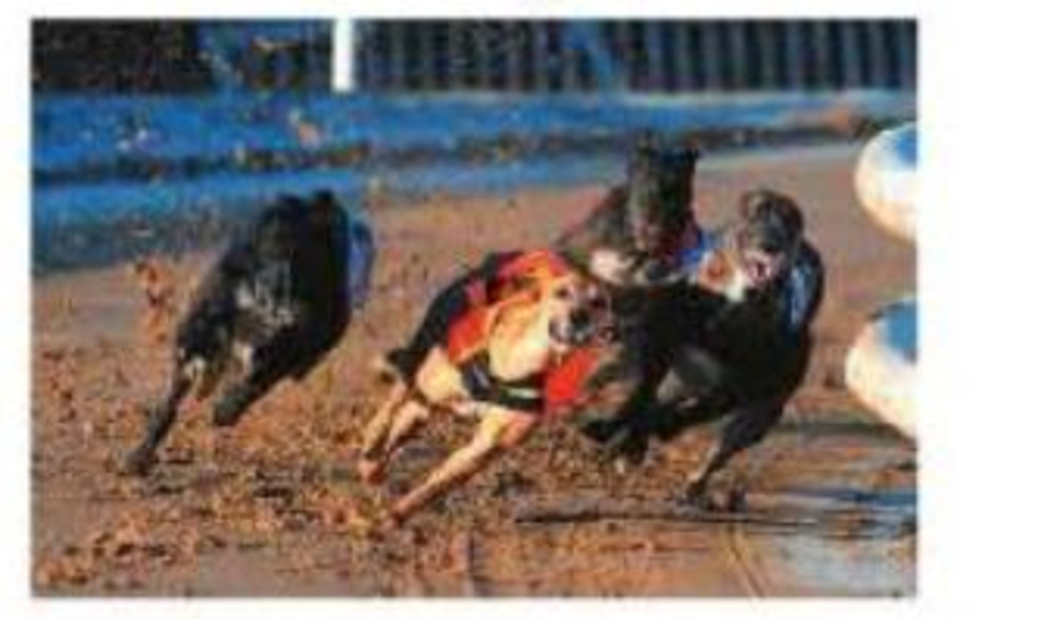
Concept explainers
Animal Athletes
Different animals have very different capacities for running. A horse can maintain a top speed of 20 m/s for a long distance but has a maximum acceleration of only 6.0 m/s2, half what a good human sprinter can achieve with a block to push against. Greyhounds, dogs especially bred for feats of running, have a top speed of 17 m /s, but their acceleration is much greater than that of the horse. Greyhounds are particularly adept at turning corners at a run.
Figure 1.1

In the photograph of the greyhounds in Figure I.1, what is the direction of the net force on each dog?
A. Up
B. Down
C. Left, toward the outside of the turn
D. Right, toward the inside of the turn
Want to see the full answer?
Check out a sample textbook solution
Chapter P Solutions
College Physics: A Strategic Approach (4th Edition)
Additional Science Textbook Solutions
Cosmic Perspective Fundamentals
Tutorials in Introductory Physics
Modern Physics
Essential University Physics: Volume 2 (3rd Edition)
University Physics with Modern Physics (14th Edition)
University Physics (14th Edition)
- Two marbles roll off a table top that is 2 meters high. The marbles roll off the table at the same time, but with different speeds. The red marble has a speed of 3 m/s, while the blue marble has a speed of 6 m/s. Which is true? A.The blue marble will strike the ground in less time than the red marble. B.The red marble will strike the ground in less time than the blue marble. C.It is impossible to determine the time the marbles will take to reach the ground unless their mass is known .D.The red and blue marbles will strike the ground at the same time.arrow_forwardWhich of the following best describes why objects can move in a circular path? a. The inertia of the objects pushes them along the circular path b. A centripetal force pushes them toward the center of the circular path. c. The momentum of the objects pushes them along the circular path. d. A centrifugal force pushes them along the circular path.arrow_forwardWrite complete solutionarrow_forward
- A child is playing with a ball on a level surface. She gives the ball a push to get it rolling, then the ball rolls a short distance before coming to a stop. Which of the following explains why the ball slows to a stop? a. the child stopped pushing it b. the speed is proportional to the force c. there must have been some force on the ball opposing the direction of motion d. the net force on the ball was zero, so it wanted to remain stationaryarrow_forwardScientific Narrative 14 Using your HW Guide as a resource, write a scientific narrative paragraph for the following prompt: How can a ball bouncing up and down be used to describe acceleration?arrow_forwardAdv physics question please solve itarrow_forward
- Q2.1 It was Isaac Newton who first described the idea of an "escape velocity" required to launch an object so that it could break free of the Earth's gravity. Describe the method we use to calculate escape velocity using the energy conservation law.arrow_forwardNeed help not sure if am doing right step by step pleasearrow_forwardQ2arrow_forward
- 1. There are how many laws of motion?a. 5 b. 2 c. 3 d. 4 2. Which law of motion is also known as Law of Inertia?a. Newton’s 1st Law c. Newton’s 2nd Lawb. Newton’s 3 rd Law d. All of the above 3. When an object at rest velocity and acceleration is zeroa. object starts to move c. object continues to be at motionb. object continues to be at rest d. none of the above 4. Which is the Newton’s3rd Law of motion?a. The rate of change of linear momentum is equal to force acting on the body.b. An object will remain at rest or in uniform motion in a straight line unless acted upon by an external forcec. All forces in the universe occur in equal but oppositely directed pairs.d. None of these. 5. When we kick a ball, force is exerted in _________a. specific direction c. multi forceb. all direction d. none of the abovearrow_forwardcan you do number 67 please.arrow_forwardQUESTION 3 A sled sits at the top of an icy hill that is 20 m tall. What is (the magnitude of) the velocity of the sled at the bottom of the hill? Assume there's no friction between the sled and the hill, and that the sled starts from rest.arrow_forward
 College PhysicsPhysicsISBN:9781285737027Author:Raymond A. Serway, Chris VuillePublisher:Cengage Learning
College PhysicsPhysicsISBN:9781285737027Author:Raymond A. Serway, Chris VuillePublisher:Cengage Learning Physics for Scientists and Engineers: Foundations...PhysicsISBN:9781133939146Author:Katz, Debora M.Publisher:Cengage Learning
Physics for Scientists and Engineers: Foundations...PhysicsISBN:9781133939146Author:Katz, Debora M.Publisher:Cengage Learning Glencoe Physics: Principles and Problems, Student...PhysicsISBN:9780078807213Author:Paul W. ZitzewitzPublisher:Glencoe/McGraw-Hill
Glencoe Physics: Principles and Problems, Student...PhysicsISBN:9780078807213Author:Paul W. ZitzewitzPublisher:Glencoe/McGraw-Hill College PhysicsPhysicsISBN:9781305952300Author:Raymond A. Serway, Chris VuillePublisher:Cengage Learning
College PhysicsPhysicsISBN:9781305952300Author:Raymond A. Serway, Chris VuillePublisher:Cengage Learning Physics for Scientists and Engineers, Technology ...PhysicsISBN:9781305116399Author:Raymond A. Serway, John W. JewettPublisher:Cengage Learning
Physics for Scientists and Engineers, Technology ...PhysicsISBN:9781305116399Author:Raymond A. Serway, John W. JewettPublisher:Cengage Learning





